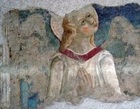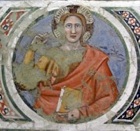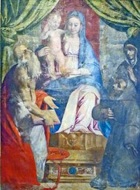

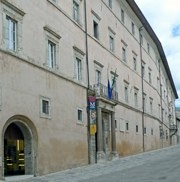
The Pinacoteca Comunale, which was formed in 1912, occupied part of the ground floor of the Palazzo dei Priori from 1933 until 1997. It re-opened in Palazzo Giacobetti Vallemani (at number 12 Via San Francesco) in 2007. Opening hours are published on the website of Assisi Online.
Works from Palazzo del Capitano del Popolo
Fresco Fragments (13th century)
These fresco fragments from the Palazzo del Capitano del Popolo are among the few examples of secular civic art that survive from 13th century Italy:
-
✴The largest of them depicts three figures of horseback:
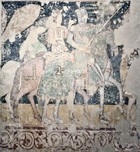
-
•a knight;
-
•a crowned female; and
-
•her page.
-
The cloth over the knights’ horse bears the Angevin lilies (picked out in black in this photograph), suggesting that this fresco might have related to the visit of Charles d Anjou, King of Naples to Assisi in 1267.
-
✴Other fragments include two scenes from a series of labours of the months (including this one for November).
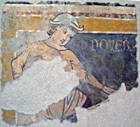
Maestà Civica (late 13th century)
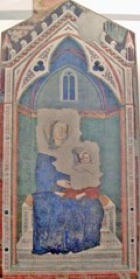
Madonna del Popolo (ca. 1318)
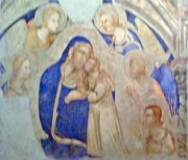
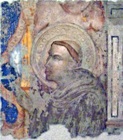
This fresco, which came from a shrine on the exterior of San Nicolò di Piazza, is usually attributed to an unknown follower of Simone Martini. It originally depicted the Madonna and Child enthroned with SS Francis and Clare, who interceded for Assisi.
-
✴The lower part of it was largely destroyed, perhaps in the earthquake of 1832.
-
✴The upper part was rehoused in the new shrine on the façade of the Palazzo delle Poste in 1929. It was subsequently removed for restoration and moved, along with a fragment of the head of St Francis, to the Pinacoteca.
Annunciation (mid 14th century)
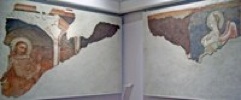
These large fresco fragments, which came from the Oratorio di San Gregorio, are attributed to Pace di Bartolo. Elvio Lunghi (referenced below, p. 286, entry 118) suggested that Puccio Capanna completed the figure of the angel.
Fragment of a Maestà and saints (1341)
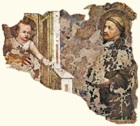
This precious fragment is the only surviving work that is securely attributable to Puccio Capanna and forms the basis for attributing other works to him on stylistic grounds: the other documented work by these two artists, for another city gate, has been lost. Giorgio Vasari, who was obviously unaware of the commissioning document, attributed this work to Tommasa di Stefano, Giottino.
Frescoes from Santa Caterina (14th century)
These frescoes from Santa Caterina (which are in two adjacent rooms of the museum) include:

-
✴a fragment depicting three men with knives from a much larger fresco; and

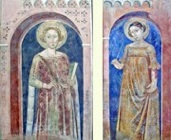
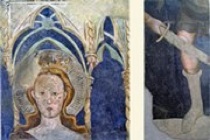
-
✴other, slightly later frescoes that are attributed to a follower of Pace di Bartolo:
-
•a fragment from the martyrdom of St Stephen;
-
•figures of St Catherine of Alexandria and another female saints; and
-
•other fragments, including the head of a femele saint and the leg of a soldier illustrated above.
Frescoes from Castello di Mora (15th century)
These votive frescoes from the parish church of Castello di Mora include;
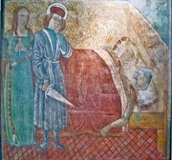
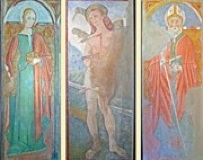
-
✴a narrative scene of St Julian after he had murdered his parents (illustrated above, to the left);
-
✴figures of SS Lucy (dated 1494), Sebastian and Nicholas of Bari (illustrated above, to the right);
-
✴a particularly archaic Coronation of the Virgin; and
-
✴fragments of St Antony of Padua and another of St Christopher carrying the infant Christ.
From Castello di San Gregorio (16th century)
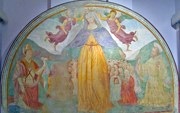
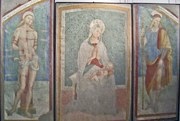
These votive frescoes from the parish church of Castello di San Gregorio include:
-
✴an Annunciation;
-
✴a Madonna della Misericordia (and angels crowing the Madonna) with SS Rufinus and Francis, set in a landscape (illustrated above, to the left);
-
✴a Madonna and Child with SS Roch and Sebastian (illustrated above, to the right).
Frescoes from the Ospedale dei Pellegrini
The Ospedale dei Pellegrini, which belonged to the Confraternita di SS Antonio e Giacomo, was demolished in 1833, although its chapel, the Oratorio dei Pellegrini, survives. A number of frescoes that were detached from the facade the hospice before its demolition are displayed here:
-
✴the Madonna and Child enthroned with SS James and Antony Abbot and kneeling donors (ca. 1422) by Ottaviano Nelli;

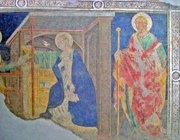

-
✴two frescoes (ca. 1422) attributed to the workshop of Ottaviano Nelli:
-
•the Virgin of an Annunciation and St James; and
-
•St Lucy; and
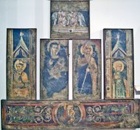
Frescoes from Fonte di Moiano (ca. 1500)
A number of frescoes from a site near the Fonte di Moiano are known from documents. The surviving fragments, which are attributed to Tiberio d' Assisi, depict:
Madonna and Child
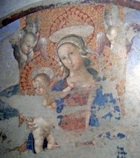
St Rufinus
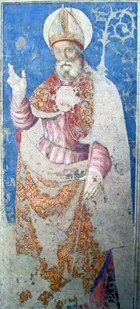
Madonna and Child (ca. 1500)
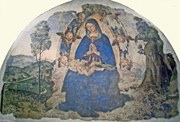
This poorly preserved fresco of the Madonna and Child in a landscape under an arch of seraphim, which is attributed to Andrea d' Assisi, l' Ingegno, came from Porta San Giacomo. (It was first documented in 1859, with an attribution to “Andrea Eloigi”, and the work is fundamental to any attempt to assemble a catalogue of his surviving works).
Frescoes (ca. 1500) from Sant’ Andrea
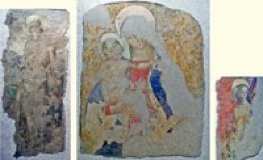
These poorly preserved frescoes, which are attributed to Andrea d' Assisi, l' Ingegno, came from the Monastero di Sant’ Andrea. They depict:
-
✴St Jerome;
-
✴the Madonna and Child; and
-
✴St Catherine of Alexandria.
Works from the Oratorio di San Crispino
The Confraternita di Santa Maria del Vescovado, which incorporated the Confratenita di San Biagio (the Woolworkers' Guild), commissioned a number of works for their oratory, which was known as the Oratorio di San Crispino from 1790:
Crucifixion (early 14th century)
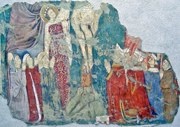
In this fragment of the lower part of a fresco of the Crucifixion, a female saint (probably St Elizabeth of Hungary) and two groups of devotees kneel at the foot of the Cross.
Frescoes (mid 14th century)
These frescoes from the refectory include:

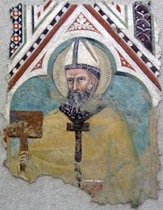
-
✴the autograph works of the so-called Maestro di San Crispino:
-
•St Onuphrius as a hermit, with a kneeling donor; and
-
•St Blaise with the instrument of his martyrdom (a wool carder’s comb);
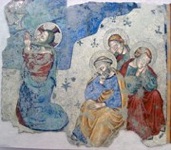
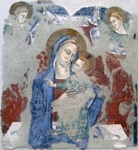
-
✴two works attributed to Pace di Bartolo:
-
•the agony in the garden; and
-
•a fragment of the Madonna and Child with angels;
-
✴God the Father (in very poor condition), by Matteo da Gualdo.
Processional Banner (ca. 1462)
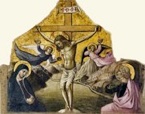
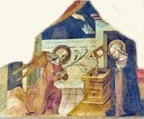
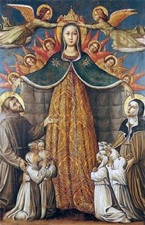
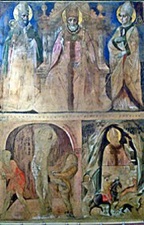
The two sides of this banner from the Oratorio di San Crispino have been transferred onto separate canvases:
-
✴The main panel depicts the Madonna della Misericordia crowned by angels, with St Francis commending the sisters and St Clare the brothers of the confraternity.
-
✴Its reverse depicts St Blaise enthroned with SS Rufinus and Victorinus, above two scenes from the life of St Blaise:
-
•his flagellation (on the left); and
-
•his help to a pagan knight fleeing from persecution, whom he hid in his grotto.
This part of the banner was first documented in the oratory in 1859, when it served as an altarpiece: the second side was turned to the wall, which probably explains its poor state of preservation.
In 1912, the scholar Umberto Gnoli recognised a banner in the Musée des Beaux Arts, Angoulême as a twin of this banner in Assisi. It had been first documented in 1858 in the collection of the disgraced Roman, Giovanni Pietro Campana. This collection had been sold to the French government in 1863. The banner moved from Angoulême to the Musée du Petit Palais, Avignon in 1974.
The history of these banners probably goes back to 1462, when Giacomo di Bartoluccio left money in his will for a processional banner for the oratory. This presumably provided the funds for at least one of them. Each has been attributed to Nicolò di Liberatore, l' Alunno or his workshop throughout its documented history: most scholars hold that the banner in Assisi was a workshop copy of the one in Avignon, but some hold that the reverse is the case.
A double-sided panel in the Pinacoteca which depicts:
-
✴the Crucifixion with the Virgin and St John the Evangelist; and
-
✴the Annunciation,
can be associated with the banner there, albeit that it had been separated from the main panel by 1859: only the side depicting the Crucifixion was visible at that time, when it served as the upper part of the altarpiece on the main altar. The reconstruction illustrated above is based on the iconography of the banner in Avignon, which had passed into the Campanna collection in its entirety.
Crucifix (early 14th century)
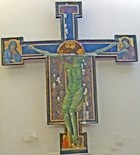
Madonna and Child with saints (ca. 1500)
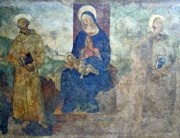
This fresco from the arch in the Vicolo di Sant Antonio (see Walk II), which is attributed to Tiberio d' Assisi, depicts the Madonna and Child with St Francis and another (damaged) saint (presumably St Antony of Padua).
Panels from Palazzo dei Priori (1565-6)
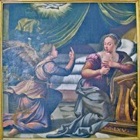
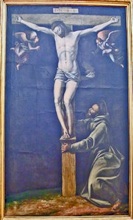
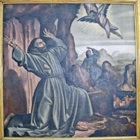
These altarpieces from the chapel of the Palazzo dei Priori, which are attributed to Dono Doni, depict:
-
✴the Annunciation, which is dated by inscription;
-
✴the Crucifixion with St Francis; and
-
✴the Stigmatisation of St Francis.
Frescoed Room
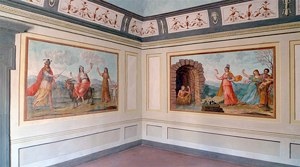
[More]
Madonna and Child with saints (1599)
-
✴one in 1596 for a signed panel of the Madonna and Child in glory with six saints, which has been lost; and
-
✴a second in 1599.
This second payment has been associated with this panel from the church, which is now in the gallery. It depicts the Madonna and Child with SS Jerome, Francis and Clare.
St Francis blessing Assisi (1626)
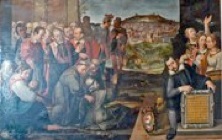
A document of 1841 records that Cesare Sermei painted this panel and presented it to the Commune in gratitude for the award of citizenship of Assisi (an event that was wrongly dated as 1596 instead of 1611). The panel was also documented again in 1884, when it was in the Sala del Consiglio of the Palazzo dei Priori.
In the panel, two friars support the stricken St Francis as he blesses the Assisi as he is being taken from Palazzo Vescovile to the Portiuncula, which was where he wanted to die. He is surrounded by the civic leaders of Assisi. The kneeling figure to the right holds an inscription that gives the date and the text of the blessing of St Francis from the “Liber de conformitate” (1399) of Bartholomew of Pisa. This figure is probably a self-portrait of Cesare Sermei, and the arms to his right are probably his own. The three women behind him probably represent Virtues.
Panels from Palazzo dei Priori (1657)
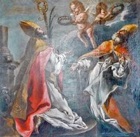
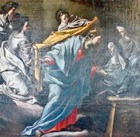
These panels by Giacomo Giorgetti, which originally decorated the ceiling of the Sala del Consiglio of the Palazzo dei Priori, depict:
-
✴SS Rufinus and Victorinus receiving crowns of martyrdom; and
-
✴St Eliabeth of Hungary appearing to the dying St Clare.
Works from Sant’ Antonio da Padova
The following panels came from Sant’ Antonio da Padova:
Marriage of the Virgin (17th century)
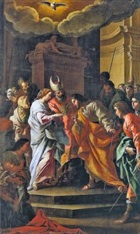
Immaculate Virgin with saints (17th century)
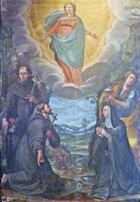
Read more:
E. Lughi, “Giotto. E I Pittori Giotteschi ad Assisi” , (2012) Marciano
Return to Museums of Assisi.
Return to Walk III.
Return to the home page on Assisi.
